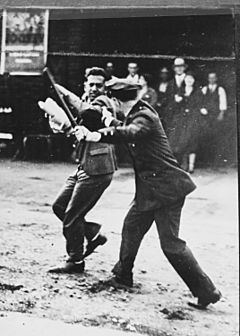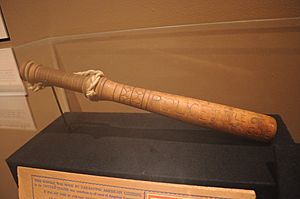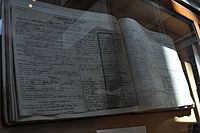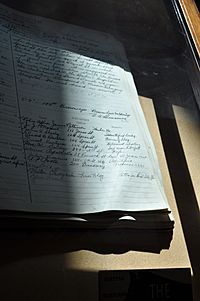1934 West Coast waterfront strike facts for kids
Quick facts for kids 1934 West Coast waterfront strike |
|||
|---|---|---|---|

Confrontation between a policeman wielding a night stick and a striker during the San Francisco General Strike, 1934
|
|||
| Date | May 9 – July 31, 1934 (84 days) | ||
| Location | |||
| Methods | Strikes, protest, demonstrations | ||
| Parties to the civil conflict | |||
|
|||
| Lead figures | |||
|
|||
| Arrests, etc | |||
|
|||
The 1934 West Coast Waterfront Strike was a big worker protest that lasted 83 days. It started on May 9, 1934, when longshoremen (dockworkers) in every port along the West Coast stopped working. The strike was organized by the International Longshore and Warehouse Union (ILWU).
The strike became very intense after two workers died on a day called "Bloody Thursday." This led to the San Francisco General Strike, where almost all work in San Francisco stopped for four days. This general strike helped lead to the end of the West Coast Longshoremen's Strike.
A major result of the strike was that all West Coast ports became unionized. This means workers joined unions to have more power together. This strike, along with others in 1934, helped lead to a big rise in industrial unionism (workers in the same industry joining unions) in the 1930s. Many of these new unions were part of the Congress of Industrial Organizations.
Contents
Why the Strike Happened
Before the strike, longshoremen on the West Coast had little power. After World War I, shipping companies made workers agree to an "open shop." This meant workers didn't have to join a union. In San Francisco, workers had to go through a special hiring system run by the companies, not by a union.
Workers wanted better conditions. They wanted more people on each work team and lighter loads to carry. Most importantly, they wanted an independent union to represent them.
In 1933, a new law called the National Industrial Recovery Act made it easier for workers to join unions. Thousands of longshoremen quickly joined the International Longshoremen's Association (ILA), which was a growing union.
Workers began to demand a contract that covered all West Coast ports. They also wanted a union-run hiring hall. This would mean the union, not the companies, would control who got hired for jobs. This was a key demand because it would give workers more control over their jobs and safety.
The main issue that caused the strike was recognition. The union wanted a "closed shop," meaning only union members could be hired. They also wanted a contract for the entire West Coast and a union hiring hall. The employers offered to talk things over, but only if the union agreed to an open shop. The longshoremen said no to this offer.
The Big Strike Begins

The strike started on May 9, 1934. Longshoremen in every West Coast port walked off the job. Sailors joined them a few days later.
The companies tried to keep the ports working by hiring strikebreakers. These were workers who crossed the picket lines. The companies housed them on ships or in special guarded areas. Police protected them as they went to work.
There were many clashes between strikers and police or strikebreakers. On May 15, strikers attacked a place where strikebreakers were staying in San Pedro. Police shot into the crowd, killing one striker named Dick Parker. This made workers even more angry. Similar fights happened daily in San Francisco, Oakland, Portland, and Seattle. Strikers also managed to slow down or stop goods from leaving the ports by train.
The government tried to help end the strike, but the workers twice voted against the agreements their leaders brought to them. The strike continued.
Employers then decided to force the port of San Francisco to reopen. On July 3, fights broke out between police and strikers along the Embarcadero in San Francisco. A few trucks driven by young businessmen managed to get through the picket lines.
Some Teamsters (truck drivers) supported the strikers. They refused to move "hot cargo," which was goods unloaded by strikebreakers. However, the Teamster leaders were not as supportive. They thought the strike had gone on too long and even threatened to use Teamsters as strikebreakers if the longshoremen didn't go back to work.
Some people, including shipping companies and government officials, tried to make people fear that the strike was caused by communists. This was part of a "Red Scare" (fear of communism).
Casualties During the Strike
Many people were hurt or killed during the strike. Here are some of the deaths:
- May 15, 1934, San Pedro, CA: Two workers, Dick Parker and John Knudsen, were killed when police shot into a crowd of strikers.
- June 30, 1934, Seattle, WA: Shelvy Daffron was shot in the back and died when union members tried to stop oil tankers from leaving the port.
- July 5, 1934, San Francisco, CA: Two workers, Nick Bordoise and Howard Sperry, were killed when police fired into a crowd of strikers. This day became known as "Bloody Thursday."
- August 20, 1934, Portland, OR: James Connor, a replacement worker, was shot and killed during a fight with strikers.
"Bloody Thursday"
After a quiet Fourth of July, employers tried to open the port of San Francisco even more on Thursday, July 5. Police used tear gas and charged at the crowds with mounted police (police on horses). Strikers threw the tear gas cans and rocks back.
The day turned very violent in the afternoon. Police fired shotguns and revolvers into the crowd. Howard Sperry, a striking longshoreman, was shot and later died. Nick Bordoise, a cook who was helping the strike, was also shot and died at the hospital.
Strikers immediately marked the spot where the men were shot with flowers. Police tried to remove the flowers, but the strikers put them back and guarded the area. Even though Sperry and Bordoise were shot in different places, this spot became a symbol of "Bloody Thursday."
As wounded strikers were carried into the union hall, police fired at the building and threw tear gas at nearby hotels.
After these events, California Governor Frank Merriam ordered the California Army National Guard (a state military force) to patrol the waterfront. Federal soldiers were also put on alert. The strikers pulled back, not wanting to fight armed soldiers. Trucks and trains began moving again.
Harry Bridges, a key strike leader, asked the San Francisco Labor Council to approve a general strike. This would mean many different types of workers would stop working. Teamsters in San Francisco and Oakland voted to strike, even though their leaders disagreed.
Funerals and General Strike
The day after "Bloody Thursday," thousands of strikers, their families, and supporters marched in a funeral procession for Nicholas Bordoise and Howard Sperry. The procession was over a mile and a half long. There were no police present. This march had a huge impact on the people of San Francisco. It made the idea of a general strike seem possible.
After many unions in the Bay Area voted for a general strike, the San Francisco Labor Council officially called for one on July 14. The Teamsters had already been on strike for two days.
San Francisco Mayor Angelo Rossi declared a state of emergency. Some federal officials were worried. President Franklin D. Roosevelt later said some people wanted him to send a warship into San Francisco Bay to end the strike, but he refused.
The general strike began on July 16, with about 150,000 workers joining. On July 17, police arrested over 300 "radicals" and destroyed property of strike-related organizations. General Hugh S. Johnson, a government official, spoke out against the general strike, calling it a "menace to the government."
The general strike lasted four days. Non-union truck drivers joined on the first day. Movie theaters and nightclubs closed. Food deliveries continued with the strike committee's permission. Many small businesses closed, showing support for the strikers. There were also reports that unions in Portland and Seattle might start general strikes too.
End of the Strike
The general strike had an unexpected effect. It gave a different committee, less militant than the longshoremen's, control over the maritime strike. When the Labor Council voted to end the general strike, they also suggested that unions agree to arbitration. This means having an outside person or group make a decision to settle the dispute.
The employers' proposal to arbitrate was put to a vote for the striking longshoremen. It passed in every port except Everett, Washington.
However, this left the striking seamen (sailors) in a difficult spot. Employers refused to arbitrate with their union unless they first won elections on the ships. Harry Bridges, who believed in strong worker unity and didn't like arbitration, apologized to the seamen.
On July 17, 1934, the California National Guard and police raided union offices and a soup kitchen. They arrested many people and destroyed property. The employers' group had agents with the police during these raids. Other raids happened at workers' schools and offices.
General Hugh S. Johnson urged union leaders to remove "subversive influences" from their groups. A lawyer for the American Civil Liberties Union was kidnapped and beaten. In some towns, people put up signs threatening "Reds."
What Happened Next
Even though some powerful people thought the strike ended in a win for employers, many longshoremen and seamen didn't see it that way. Workers started small, unplanned strikes over problems and working conditions. Employers often gave in to these demands. This made workers feel even more confident to demand things like lighter loads.
The arbitration award (the decision made by the outside group) was given on October 12, 1934. It greatly increased the ILA's power. The union was given the power to choose the dispatcher for the hiring hall. This meant the union controlled who got hired for jobs on the docks. Employers complained that the union wanted to "sovietize" (take over) the waterfront. Workers complained that employers were using them for cheap labor and making them work in unsafe conditions.
The union quickly used "quickie strikes" (short, unplanned strikes) to get more from employers, like safer working conditions and better pay. Even when an arbitrator said the union couldn't do "sympathy strikes" (strikes to support other unions), members still refused to cross other unions' picket lines. Longshoremen also refused to handle "hot cargo" (goods from non-union warehouses).
The relationship between the seamen's and longshoremen's unions became more complicated over the years. In 1937, the West Coast ILA broke away to form the International Longshoremen's Union. It was later renamed the International Longshore and Warehouse Union (ILWU) to include warehouse workers and women members.
The arbitration award also gave longshoremen a raise to 95 cents an hour for regular work. This was almost the dollar an hour they had asked for during the strike. The contract also applied to all West Coast ports. The strike also inspired Carmen Lucia to organize department store workers and retail clerks in San Francisco.
Legacy of the Strike
The ILWU still remembers "Bloody Thursday" every year. All West Coast ports shut down on July 5 to honor Nick Bordoise, Howard Sperry, and all other workers killed during the strike.
The ILWU has often stopped work for political protests. They have protested against things like Italy's invasion of Ethiopia, fascism (a type of harsh government) in Spain's civil war, South Africa's system of apartheid (racial segregation), and the Iraq War.
Sam Kagel, the last surviving member of the original union committee, passed away on May 21, 2007, at 98 years old.



